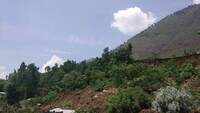
Nagpur: Around 269 protected areas (PAs) in 18 states are in the grip of lantana, an invasive weed that has degraded biodiversity of forests and associated services. Of the over 2,00,000 sqkm forest surveyed, lantana was detected in over 86,800sqkm.
Through one of the most extensive sampling efforts, a team of three Wildlife Institute of India (WII) scientists including Ninad Avinash Mungi, Qamar Qureshi and YV Jhala found that over 300,000sqkm (44%) of total Indian forests were affected by lantana. The survey was conducted in forests of Shivalik Hills in the north, Central India and southern Western Ghats.
The study uses data to develop an accurate countrywide map of lantana invasion for informed conservation actions. By combining this information with globally available information on lantana, the scientists investigated environmental factors that facilitate lantana invasion globally and in India in particular.
“Lantana camara (sensu lato) is a species of global concern. In an unprecedented effort, we sampled 13,715 grids of 5×5km to record its abundance. Lantana has invaded over 15,400sqkm of the surveyed area and threatened over 3 lakh sqkm of total Indian forests (44%) with preference to warm, humid, fertile areas, degraded by extractive human use,” said Mungi, the lead author of the study.
By combining the large-scale ground surveys, the study found lantana had expanded its climatic niche worldwide with over 11 million sqkm suitable for its invasion. Niche comparison revealed that lantana might have adaptive plasticity in its invaded range - where it was found to be more tolerant to higher temperatures, lower fertility and shade as compared to its native range.
Over extraction of natural resources for livelihood in developing countries has degraded native ecosystems, making them vulnerable to biological invasions. Amongst invasive plants, Lantana camara, a woody shrub of tropical American origin, is regarded as one of the 10 worst species and a major concern in India. Despite 200 years of managing lantana in India, little information regarding its distribution at the country level or its biogeographic correlates is available, researchers said.
Previous studies found multiple species and varieties of lantana across the tropics where it was introduced in 1800s. These species and varieties were introduced as hedge plants and were subsequently hybridized for improved stand and other ornamental properties. This added to the number of varieties, which were later reported to invade native forests.
The study reveals dense invasion of lantana has been suspected to cause a decline in wildlife habitat and native plants and has also affected livelihood of communities dependent on forest resources. Its distribution is known to be influenced by native forest fragmentation in invaded areas and estimated forest loss in India is considered to be at the rate of 173sqkm annually.
At rough estimates, its management is estimated to cost around Rs 14 lakh per sqkm in India. The work was supported by the WII and funded by the National Tiger Conservation Authority (NTCA).
DEGRADING OUR FORESTS
* The sampling was conducted between November 2009 and March 2010. Over 1.17 lakh plots were sampled within 13,700 grids covering 207,107 km2 of forested area
* Lantana prefers warm and humid areas. As most of the warm and humid forests in India are occupied by dense woody plants, the understory shrub density is mostly determined by light availability, which is a function of forest canopy cover as well as forest degradation
* Studies suggest that frequent burning of forests was likely to facilitate lantana invasion
* Human disturbances like tree cutting, tree lopping, and grazing can remove the native plants thereby reducing competition and making conditions favourable for lantana
Through one of the most extensive sampling efforts, a team of three Wildlife Institute of India (WII) scientists including Ninad Avinash Mungi, Qamar Qureshi and YV Jhala found that over 300,000sqkm (44%) of total Indian forests were affected by lantana. The survey was conducted in forests of Shivalik Hills in the north, Central India and southern Western Ghats.
The study uses data to develop an accurate countrywide map of lantana invasion for informed conservation actions. By combining this information with globally available information on lantana, the scientists investigated environmental factors that facilitate lantana invasion globally and in India in particular.
“Lantana camara (sensu lato) is a species of global concern. In an unprecedented effort, we sampled 13,715 grids of 5×5km to record its abundance. Lantana has invaded over 15,400sqkm of the surveyed area and threatened over 3 lakh sqkm of total Indian forests (44%) with preference to warm, humid, fertile areas, degraded by extractive human use,” said Mungi, the lead author of the study.
By combining the large-scale ground surveys, the study found lantana had expanded its climatic niche worldwide with over 11 million sqkm suitable for its invasion. Niche comparison revealed that lantana might have adaptive plasticity in its invaded range - where it was found to be more tolerant to higher temperatures, lower fertility and shade as compared to its native range.
Over extraction of natural resources for livelihood in developing countries has degraded native ecosystems, making them vulnerable to biological invasions. Amongst invasive plants, Lantana camara, a woody shrub of tropical American origin, is regarded as one of the 10 worst species and a major concern in India. Despite 200 years of managing lantana in India, little information regarding its distribution at the country level or its biogeographic correlates is available, researchers said.
Previous studies found multiple species and varieties of lantana across the tropics where it was introduced in 1800s. These species and varieties were introduced as hedge plants and were subsequently hybridized for improved stand and other ornamental properties. This added to the number of varieties, which were later reported to invade native forests.
The study reveals dense invasion of lantana has been suspected to cause a decline in wildlife habitat and native plants and has also affected livelihood of communities dependent on forest resources. Its distribution is known to be influenced by native forest fragmentation in invaded areas and estimated forest loss in India is considered to be at the rate of 173sqkm annually.
At rough estimates, its management is estimated to cost around Rs 14 lakh per sqkm in India. The work was supported by the WII and funded by the National Tiger Conservation Authority (NTCA).
DEGRADING OUR FORESTS
* The sampling was conducted between November 2009 and March 2010. Over 1.17 lakh plots were sampled within 13,700 grids covering 207,107 km2 of forested area
* Lantana prefers warm and humid areas. As most of the warm and humid forests in India are occupied by dense woody plants, the understory shrub density is mostly determined by light availability, which is a function of forest canopy cover as well as forest degradation
* Studies suggest that frequent burning of forests was likely to facilitate lantana invasion
* Human disturbances like tree cutting, tree lopping, and grazing can remove the native plants thereby reducing competition and making conditions favourable for lantana

Coronavirus outbreak
Trending Topics
LATEST VIDEOS
City
 Maharashtra: 3 cops dismissed from service in Palghar lynching case
Maharashtra: 3 cops dismissed from service in Palghar lynching case  Fresh India-China face-off in Ladakh: Srinagar-Leh highway closed for civilians
Fresh India-China face-off in Ladakh: Srinagar-Leh highway closed for civilians  SSR death probe: Dean of Cooper Hospital quizzed with regards to Rhea Chakraborty’s entry in mortuary
SSR death probe: Dean of Cooper Hospital quizzed with regards to Rhea Chakraborty’s entry in mortuary  Decline in medical condition of former President Pranab Mukherjee: Army hospital
Decline in medical condition of former President Pranab Mukherjee: Army hospital
More from TOI
Navbharat Times
Featured Today in Travel
Quick Links
Kerala Coronavirus Helpline NumberHaryana Coronavirus Helpline NumberUP Coronavirus Helpline NumberBareilly NewsBhopal NewsCoronavirus in DelhiCoronavirus in HyderabadCoronavirus in IndiaCoronavirus symptomsCoronavirusRajasthan Coronavirus Helpline NumberAditya ThackerayShiv SenaFire in MumbaiAP Coronavirus Helpline NumberArvind KejriwalJammu Kashmir Coronavirus Helpline NumberSrinagar encounter
Get the app



